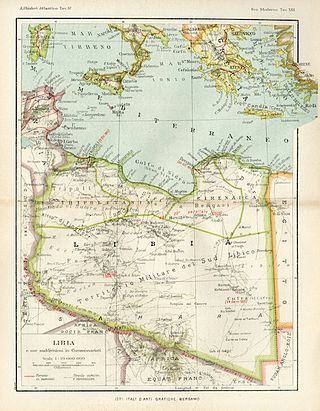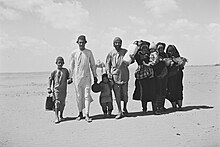Antisemitism has increased greatly in the Arab world since the beginning of the 20th century, for several reasons: the dissolution and breakdown of the Ottoman Empire and traditional Islamic society; European influence, brought about by Western imperialism and Arab Christians; Nazi propaganda and relations between Nazi Germany and the Arab world; resentment over Jewish nationalism; the rise of Arab nationalism; and the widespread proliferation of anti-Jewish and anti-Zionist conspiracy theories.

The Jewish exodus from the Muslim world was the migration, departure, flight and expulsion of around 900,000 Jews from Arab countries and Iran, mainly from 1948 to the early 1970s, though with one final exodus from Iran in 1979–80 following the Iranian Revolution. An estimated 650,000 of the departees settled in Israel.

Yishuv, Ha-Yishuv, or Ha-Yishuv Ha-Ivri denote the body of Jewish residents in the Land of Israel prior to the establishment of the State of Israel in 1948. The term came into use in the 1880s, when there were about 25,000 Jews living across the Land of Israel, and continued to be used until 1948, by which time there were some 630,000 Jews there. The term is still in use to denote the pre-1948 Jewish residents in the Land of Israel.

The 1920 Nebi Musa riots or 1920 Jerusalem riots took place in British-controlled part of Occupied Enemy Territory Administration between Sunday, 4 April, and Wednesday, 7 April 1920 in and around the Old City of Jerusalem. Five Jews and four Arabs were killed, and several hundred were injured. The riots coincided with and are named after the Nebi Musa festival, which was held every year on Easter Sunday, and followed rising tensions in Arab-Jewish relations. The events came shortly after the Battle of Tel Hai and the increasing pressure on Arab nationalists in Syria in the course of the Franco-Syrian War.

Tripolitania, historically known as the Tripoli region, is a historic region and former province of Libya.

Maghrebi Jews or North African Jews are ethnic Jews who had traditionally lived in the Maghreb region of North Africa under Arab rule during the Middle Ages. Established Jewish communities had existed in North Africa long before the arrival of Sephardi Jews, expelled from Portugal and Spain. Due to proximity, the term 'Maghrebi Jews' sometimes refers to Egyptian Jews as well, even though there are important cultural differences between the history of Egyptian and Maghrebi Jews. These Jews originating from North Africa constitute the second largest Jewish diaspora group.

The history of the Jews in Libya stretches back to the 3rd century BCE, when Cyrenaica was under Greek rule. The Jewish population of Libya, a part of the Sephardi-Maghrebi Jewish community continued to populate the area continuously until the modern times. During World War II, Libya's Jewish population was subjected to anti-semitic laws by the Fascist Italian regime and deportations by Nazi German troops.
This is a list of countries where antisemitic sentiment has been experienced.

The Kingdom of Libya, known as the United Kingdom of Libya from 1951 to 1963, was a constitutional monarchy in North Africa which came into existence upon independence on 24 December 1951 and lasted until a coup d'état on 1 September 1969. The coup, led by Muammar Gaddafi, overthrew King Idris and established the Libyan Arab Republic.

Islam is the dominant religion in Libya. Other than the vast majority of Sunni Muslims, there are also small Christian communities, composed exclusively of immigrants. Coptic Orthodox Christianity, which is the Christian Church of Egypt, is the largest and most historical Christian denomination in Libya. There are over 60,000 Egyptian Copts in Libya, as they comprise over 1% of the population alone. There are an estimated 40,000 Roman Catholics in Libya who are served by two Bishops, one in Tripoli and one in Benghazi. There is also a small Anglican community, made up mostly of African immigrant workers in Tripoli; it is part of the Anglican Diocese of Egypt.
Judeo-Tripolitanian Arabic is a variety of Arabic spoken by Jews formerly living in Libya.

Tripoli Province was one of the provinces of Libya under Italian rule. It was established in 1937, with the official name: Commissariato Generale Provinciale di Tripoli. It lasted until 1947.

The 1945 Anti-Jewish riots in Tripolitania was the most violent rioting against Jews in North Africa in modern times. From November 5 to November 7, 1945, more than 140 Jews were killed and many more injured in a pogrom in British-military-controlled Tripolitania. 38 Jews were killed in Tripoli from where the riots spread. 40 were killed in Amrus, 34 in Zanzur, 7 in Tajura, 13 in Zawia and 3 in Qusabat.

The Aden riots of December 2–4, 1947 primarily targeted the Jewish community in the British Colony of Aden. The riots broke out from a planned three-day Arab general strike in protest of United Nations General Assembly Resolution 181 (II), which created a partition plan for Palestine. The riots resulted in the deaths of 82 Jews, 33 Arabs, 4 Muslim Indians, and one Somali, as well as wide-scale devastation of the local Jewish community of Aden. The Aden Protectorate Levies, a military force of local Arab-Muslim recruits dispatched by the British governor Reginald Champion to quell the riots, were responsible for much of the killing.

The Allied administration of Libya was the control of the ex-Italian colony of Italian Libya by the Allies from 13 May 1943 until Libyan independence was granted in 1951. It was divided into two parts:

The British Military Administration of Libya was the control of the regions of Cyrenaica and Tripolitania of the former Italian Libya by the British from 1943 until Libyan independence in 1951. It was part of the Allied administration of Libya.

Lebanese Jewish Migration to Israel included thousands of Jews, who moved to Israel, similar to how 1948 witnessed the emigration of hundreds of thousands of Jews from Arab countries. Yet, "unlike Jewish communities in many other Arab states, the Jewish communities in Lebanon grew after 1948 and it was not until the end of the civil war of 1975 that the community started to emigrate." This "Lebanese difference" derives from two components: more positive Lebanese relationships with European authorities during the French Mandate than experienced by other Arab states, leading to a more pluralistic outlook in Lebanon than its neighbors; some elements in the Maronite Christian community who were tolerant of Zionism.

Conditions worsened for the Jews of Libya after the passage of Italy's Manifesto of Race in 1938. Following the German intervention in 1941, some of the Jews of Libya were sent to camps in continental Europe, where those who survived stayed until the end of World War II.

The 1929 Palestine riots, Buraq Uprising or the Events of 1929, was a series of demonstrations and riots in late August 1929 in which a longstanding dispute between Muslims and Jews over access to the Western Wall in Jerusalem escalated into violence.
In June 1967, an anti-Jewish pogrom took place in the Libyan city of Tripoli.
















